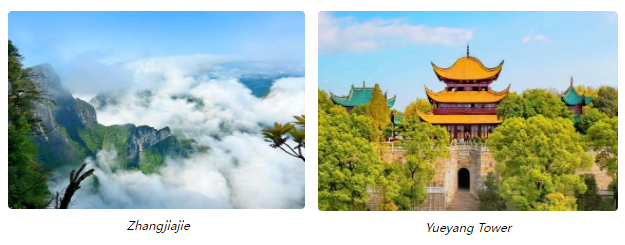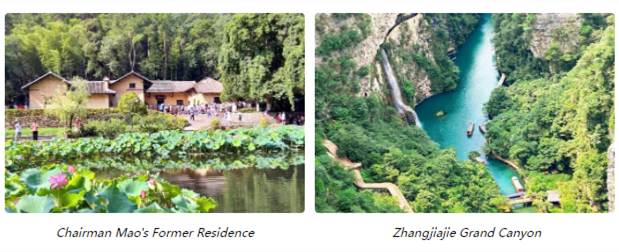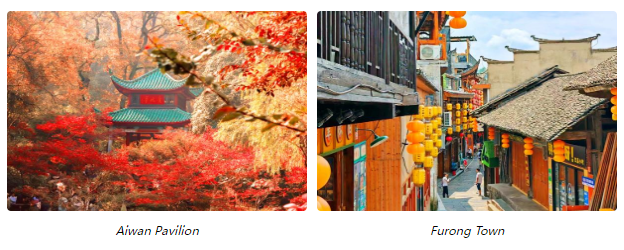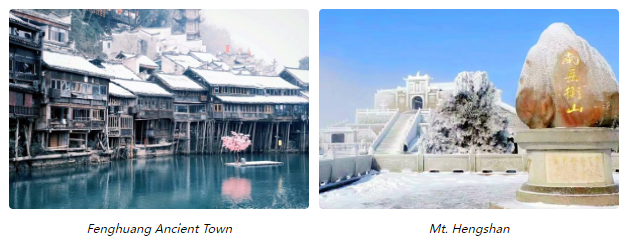In the spring of Hunan, life awakens in a tapestry of vibrant hues. The climes are gentle, the air is balmy, and April through May unravel themselves as the optimal seasons for a wanderlust's heart. Then, as the autumn arrives, the landscape transforms into a canvas of golden hues, where the breeze whispers tales of tranquility, perfect for capturing fleeting moments with a camera lens or embarking on a soul-soothing hike. September and October unfold as the most enchanting months for travelers, offering respite from the rainier seasons and the chill of winter, making them alluring choices indeed.
Hunan Weather
Characteristic
Located in the central-southern region of China, Hunan boasts a subtropical monsoon humid climate. With an annual average temperature ranging from 16 to 19℃, the overall climate is quite warm. Here, the four seasons are distinctly different. During the summer, the average temperature is mostly between 26 and 29℃, while in Hengyang, it can soar to around 30℃. The temperature difference between day and night is significant in spring and autumn, while the summer feels muggy due to high humidity. The coldest month is often January, while the warmest month is typically July.
In the southern region of Hunan, spring typically begins in early March, while in the northern areas, it is delayed until around March 20th, lasting for 65 to 75 days. As spring arrives, temperatures gradually rise, but it is often accompanied by continuous rainy days, low temperatures, and less sunshine. Starting from mid-May, summer gradually sets in from south to north. The summer in the southern regions is longer, lasting for about four and a half months, while the northern regions enjoy a shorter summer of about three and a half months. Summer is the longest season in Hunan's four seasons. In most areas, the hottest period generally starts from the end of June or early July and ends in late July or early to mid-August. Temperatures are high and the weather is as hot as fire, with concentrated rainfall during this season, which can also lead to flooding disasters.
In late September, various regions of Hunan successively enter autumn (the western part of Hunan often enters autumn in mid-September). Autumn is the shortest season, lasting for about two months. The first month is often cool, while the second month is prone to windy and rainy days. Winter usually starts in late November or early December (it can be delayed by 20 days in the southern regions and some mountainous basins) and lasts for more than three months. Although the winter temperatures in Hunan are not very low, they are relatively damp and cold, with less snowfall.
Hunan is blessed with abundant rainfall, with an average annual precipitation ranging from 1,200 to 1,700 millimeters. The rainfall is noticeably concentrated in a specific period of the year, known as the rainy season. This rainy season typically lasts for only four months (April to July), but it accounts for 50% to 60% of the annual rainfall. Among these months, June receives the heaviest rainfall, often with rain falling throughout the entire month. From a spatial distribution perspective, mountainous regions receive more precipitation than hills, and hills, in turn, receive more than plains. This climatic influence results in rich vegetation and lush crop growth in Hunan, while also providing the province with abundant water resources.
Hunan Seasons to Go
Spring (March to May)

The scenery of Hunan in spring is like a brilliantly colored painting, with every corner filled with vitality and energy. In the Orange Island Park of Changsha, various flowers bloom in succession, attracting numerous tourists to admire their beauty. Mt. Hengshan is beautiful and majestic, with verdant greenery as well as warm and comfortable breeze. Each brick and stone of Yueyang Tower seems to be awakened by the spring breeze, emanating a historical charm. The Ten-mile Natural Gallery in Wulingyuan Core Scenic Area of Zhangjiajie showcases the splendor of spring to its fullest extent. Additionally, you can ascend the mountain peaks to witness a spectacular sight of Clouds rolling and tumbling.
Summer (June to August)

Although the summer in Hunan can be hot, there are still many great places to visit. Shaoshan offers visitors an opportunity to intimately connect with nature. The vast lotus flowers blooming in front of Chairman Mao's Former Residence provide a unique sense of coolness. The temperature in Zhangjiajie Grand Canyon remains between 20~25℃ in summer, earning it the nickname of “natural large air conditioner". The refreshing mountain breeze brings a rare tranquility in the midst of the noisy summer. If you prefer indoor activities, Hunan Museum is also a great choice. It is the largest historical and art museum in Hunan Province. Here, you can delve deeply into the humanities, history, culture, and folklore of Hunan. Whether you seek the nurturing of historical culture or the enjoyment of natural beauty, these places will provide you with rich and unique travel experiences.
Autumn (September to November)

The autumn in Yuelu Mountain is a blaze of fiery maple leaves, painting the entire forest in rich hues. Beyond the allure of the maple leaves, Yuelu Mountain also boasts a rich historical and cultural legacy, such as the renowned Aiwan Pavilion. Nestled in western Hunan, Furong Town is a charming destination in autumn. The cobblestone streets, towering waterfalls, and numerous historical buildings within the town all exude a profound Miao ethnic flavor. As autumn sets in, the reeds sway gracefully in Dongting Lake, and migratory birds flock south, painting a beautiful ecological scene. Hunan is a must-visit destination for anyone seeking to immerse themselves in the rich tapestry of autumn colors and cultural heritage.
Winter (December to February)

During winter, especially in the mountainous regions, the snowscapes in Hunan are truly captivating. The trees, streams, and houses seem to be draped in a layer of white gauze, creating a stunning winter painting. Hunan's winter often brings the phenomenon of rime, particularly in places like Zhangjiajie and Mt. Hengshan. When the temperature drops below zero, trees, rocks, and other objects are adorned with a layer of crystal-clear rime, resembling silver coral, a sight of unparalleled beauty. When Changsha experiences its first snowfall, the Xiangjiang River and Orange Island Park appear even more serene and peaceful under the snow's embrace. In the snow-covered Fenghuang Ancient Town, you can quietly listen to the sound of snowflakes falling, feeling the history and culture of the ancient town. Every brick and tile here carries a profound historical memory, allowing you to appreciate the snowscapes while also experiencing the charm of this ancient city.
If you're planning a trip to Hunan, you can choose the perfect time to travel based on your preferences and by checking the weather forecast beforehand. Of course, Silk Road Travel is your trusted partner, and we'll provide you with travel tips to make your journey even more enjoyable!



































